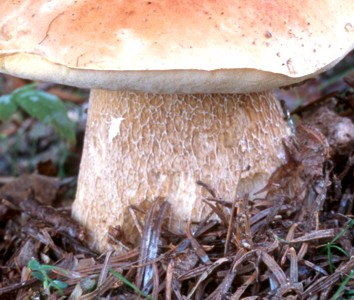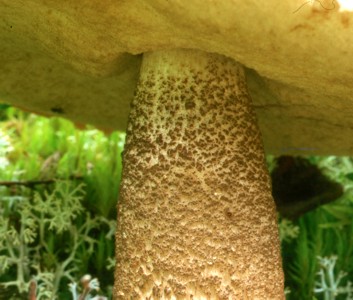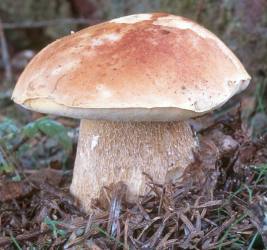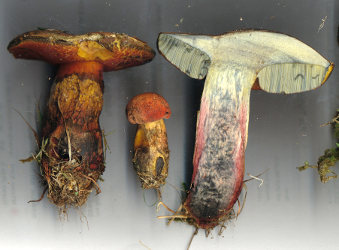Home >> Diversity and classification >> True fungi >> Dikarya >> Basidiomycota >> Agaricomycotina >> Mushrooms and boletes >> Boletes
BOLETES


Collecting wild mushrooms and boletes is an activity deeply ingrained in Russian culture. Leo Tolstoy, in his monumental novel Anna Karenina shares this love of mushrooms in one of those magical scenes that only he could create. The young intellectual Sergei Ivanovich Koznyshev becomes enamoured of a young lady named Varvara Andreevna (Varenka) and decides he will propose marriage to her. They both join a family outing to gather mushrooms and both are aware that the proposal is imminent. At the moment when this should have happened Koznyshev loses his nerve and instead discusses with Varenka the difference between the white mushroom (Boletus edulis) that everyone treasures and the somewhat less desireable birch mushroom (Leccinum scabrum). Koznyshev tells her that the stipe of the birch mushroom always reminds him of the face of a man who has not shaved for two days. Varenka agrees and the spell is broken. No proposal follows and both turn away to join the children. The photos above show these two species: guess which is which.
Most boletes form mycorrhizae, which is why Koznyshev and Varenka were out in a birch forest. Some species in the tropics may not be mycorrhizal, but those in our region apparently are. Their specificity to certain trees and shrubs is great enough that when we find a bolete we often look up to confirm that the "correct" tree is there.

The pictures above are all of species of Leccinum. The North American species of Leccinum are quite difficult to name and the ones in the pictures are only tentatively identified as, left to right, L. aurantiacum, L. atrostiptiatum, L. scabrum, Tolstoy's "birch mushroom", and L. holopus. Most species of Leccinum form mycorrhizae with birches and poplars, but there are some exceptions. For example, L. arenicola is only known from coastal sand dunes associated with beach-heather (Hudsonia tomentosa). This is a special bolete for New Brunswickers as it was first found by Dr. Scott Redhead on sand dunes in Kouchibouguac National Park on the Acadian Coast of New Brunswick.

The genus Suillus contains a variety of species forming mycorrhizae most commonly with pines. They are fairly specific to the kind of pines they will associate with, so if you travel to a place with pines that are new to you it is likely you will also see unfamiliar species of Suillus. Three species of Suillus found under pines are illustrated above: S. luteus, under jack- and scots pines, S. placidus under eastern white pine and S. pungens under Monterey- and other pines in coastal California. Most species have very slimy caps that make them unmistakable even to beginners.

Some species of Suillus are strictly associated with larch or, as it is commonly called in New Brunswick, hackmatack. Above left are three species common in our area, S. grevillei, S. cavipes and S. paluster. The first two occur across the entire boreal forest region of the world but S. paluster appears to be restricted to North America (but possibly also in Taiwan). Suillus grevillei with its slimy cap is a very typical species of the genus but the other two are relatively dry. These species also have radiating pores that suggest mushroom lamellae. The combination of dry caps and radiating pores have convinced some people that these species should be separated into the separate genus Boletinus. Suillus paluster and some related species have very dark spores which have led some mycologists to segregate them even further into the genus Fuscoboletinus. However, molecular studies carried out by Dr. Annette Kretzer and colleagues at the University of California showed that all of these fungi should be kept together in Suillus.


The genus Boletus is relatively uncomplicated in New Brunswick but becomes very diverse in warmer regions further to the south. This trend is mainly due to the proliferation of species forming mycorrhizae with oaks. However two species, B. edulis and B. subvelutipes, illustrated above, can become very abundant in northern regions, . Boletus edulis, at left, is well-known and considered to be one of the best of all edible fungi. Often called "King bolete" in North America it is the "White mushroom" sought by Koznyshev and Varenka in Anna Karenina. Boletus subvelutipes, at right, is found in both coniferous and hardwood forests. It differs from B. edulis in having the pore mouths bright red when it is young and in having flesh that turns blue when cut. This a poisonous species that can cause gastrointestinal problems, leading to the general advice not to eat any bolete that has red tube mouths or has flesh that turns blue.